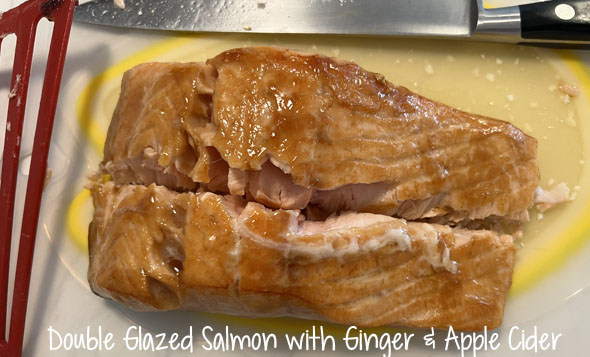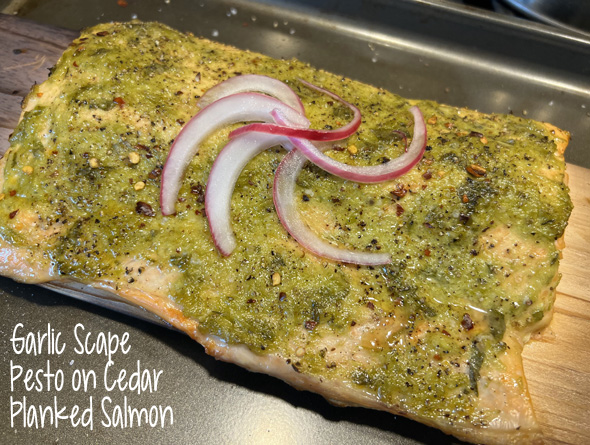Oh-so-delicious salmon with a piquant glaze that just hits all the right spots.
A post from Carolyn. A couple of weeks ago, over Easter weekend, my friend Linda joined me in Palm Desert and we had a cook-fest, of sorts. I did dinner Friday night (big green salad with chicken and freshly made popovers); we went out to lunch on Saturday (La Quinta Baking Co. had quiche – it’s a French inspired menu); I made coq au vin on Saturday night, served on a bed of delicious mashed cauliflower; Sunday morning Linda made a potato frittata, and we worked together on a lovely Easter dinner with this salmon plus a carrot salad and a tomato salad. Then I made a blueberry cobbler for dessert. All those recipes coming up soon. We had great fun. Cooked our little hearts out! Realized I don’t have a potato masher at that house, for one thing. Also have no ramekins. Not a one. So we punted. I think a stick blender is in order for that place too.
I’ve taken a lot of extra things from my Orange County home out there and we’re well-enough equipped, (the home was furnished when we bought it in 2020, my daughter Sara and her husband John and I), and came with a moderately outfitted kitchen, just not everything to my/our liking for quality or quantity). Most of the knives went into the donation bag. So did lots of the dishes and pots and pans and utensils. It was obvious the previous owners weren’t cooks, or they didn’t value good quality kitchen equipment, for sure. We joke that the wife (we guess) bought most of her kitchen stuff at the 99¢ store or perhaps at the Goodwill store. Maybe some at Marshall’s or Home Goods. Over the years I’d gathered duplicates of many things, so nearly every time I drive out, I take something else to use there.
So, this salmon. It was first published in Cook’s Illustrated last fall (2022) and it’s been on America’s Test Kitchen also. In any case, this recipe is a blue-ribbon, first class winner. I just loved it.
 The salmon (Linda bought it at an upscale fish market in Carlsbad before she drove to the desert) was briefly brined in a salt and sugar mixture. Only for 15 minutes, then they were dried carefully with paper towels before proceeding. She made the glaze: apple cider (she used apple juice), cider vinegar, sugar, soy sauce, ginger, oil and cornstarch. The glaze is Asian inspired – since it has soy and ginger in it, but it’s not an overwhelming flavor. The recipe was developed by Lan Lam, if you’ve watched her on any of the episodes on tv. The salmon was briefly sauteed to get it golden brown on top, then flipped over, and the first glazing happened just before it went into a warm oven (300°F) to finish cooking. Once removed, some of the set-aside glaze was brushed all over the salmon, top and sides. A garnish of chives went on top and we sat down to eat it. The only mistake we made was to wait until after baking to slice it into serving portions, so we didn’t have neatly sliced sides. Have the rest of your dinner fully prepared so you can sit down to eat it as soon as it comes out of the oven.
The salmon (Linda bought it at an upscale fish market in Carlsbad before she drove to the desert) was briefly brined in a salt and sugar mixture. Only for 15 minutes, then they were dried carefully with paper towels before proceeding. She made the glaze: apple cider (she used apple juice), cider vinegar, sugar, soy sauce, ginger, oil and cornstarch. The glaze is Asian inspired – since it has soy and ginger in it, but it’s not an overwhelming flavor. The recipe was developed by Lan Lam, if you’ve watched her on any of the episodes on tv. The salmon was briefly sauteed to get it golden brown on top, then flipped over, and the first glazing happened just before it went into a warm oven (300°F) to finish cooking. Once removed, some of the set-aside glaze was brushed all over the salmon, top and sides. A garnish of chives went on top and we sat down to eat it. The only mistake we made was to wait until after baking to slice it into serving portions, so we didn’t have neatly sliced sides. Have the rest of your dinner fully prepared so you can sit down to eat it as soon as it comes out of the oven.
What’s GOOD: oh my goodness, this was off-the-charts delicious. SO tender, so flavorful, and the glaze just makes it. Succulent, cooked to perfection to 125°F internal temperature. Do use an instant read thermometer. Have a heated platter or plates ready. Dig in.
What’s NOT: nothing really. This is a keeper.
printer-friendly PDF and MasterCook file (click link to open recipe)
* Exported from MasterCook *
Double-Glazed Salmon with Ginger and Apple Cider
Recipe By: Cook’s Illustrated, Sept/Oct 2022
Servings: 4
BRINE:
1/4 cup salt — for brining
1/4 cup sugar — for brining
FISH:
2 pounds salmon fillets — 6-8 ounces each
1/3 cup apple cider — or apple juice
3 tablespoons apple cider vinegar
2 tablespoons sugar
4 teaspoons soy sauce
1 1/2 teaspoons cornstarch
1 piece ginger — 1″ piece, peeled, smashed
1/2 teaspoon vegetable oil
1 tablespoon chives — minced, or parsley
Notes: If apple cider is unavailable, substitute apple juice and increase the amount of cornstarch to 1¾ teaspoons. Use the bottom of a small saucepan or skillet to smash the ginger. To ensure uniform cooking, buy a 1½- to 2-pound center-cut salmon fillet and cut it into four pieces. If your salmon is less than 1 inch thick at its thickest point, check for doneness after 10 minutes of roasting in step 3.
1. Adjust oven rack to middle position and heat oven to 300°F. Dissolve salt and ¼ cup sugar in 2 quarts cold water in large container. Submerge salmon fillets in brine and let stand at room temperature for 15 minutes. Remove fillets from brine and pat dry with paper towels.
2. Meanwhile, combine cider, vinegar, sugar, soy sauce, and cornstarch in small saucepan and stir until no lumps remain. Add ginger and bring to simmer over medium-high heat, stirring frequently. Continue to cook, stirring frequently, until thickened, about 1 minute longer. Remove from heat and let ginger steep for at least 5 minutes. Discard ginger and transfer 2 tablespoons glaze to small bowl.
3. Heat oil in 12-inch ovensafe nonstick skillet over medium-high heat until just smoking. Place fillets, flesh side down, in skillet and cook until flesh side is well browned, 2 to 3 minutes. Flip fillets and reduce heat to low. Brush tops of fillets with reserved 2 tablespoons glaze. Transfer skillet to oven and cook until centers are still translucent when checked with tip of paring knife and register 125 degrees (for medium-rare), 10 to 15 minutes. Wash and dry brush.
4. Brush remaining glaze on top and sides of each fillet and sprinkle with chives or parsley. Transfer to platter or individual plates and serve.
Per Serving: 370 Calories; 9g Fat (23.1% calories from fat); 46g Protein; 23g Carbohydrate; trace Dietary Fiber; 168mg Cholesterol; 7348mg Sodium; 21g Total Sugars; 0mcg Vitamin D; 35mg Calcium; 2mg Iron; 1036mg Potassium; 655mg Phosphorus.























Leave a Comment!